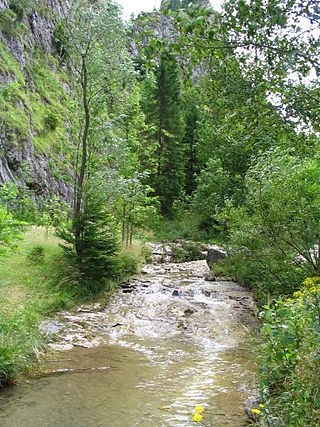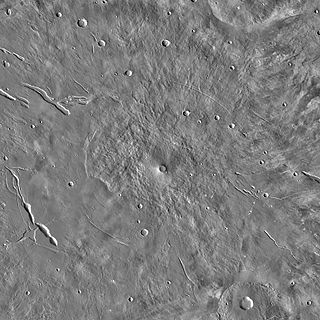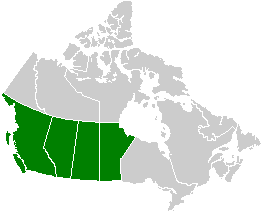
Olympus Mons is a large shield volcano on Mars. It is over 21.9 km high as measured by the Mars Orbiter Laser Altimeter (MOLA), about 2.5 times the elevation of Mount Everest above sea level. It is Mars's tallest volcano, its tallest planetary mountain, and is approximately tied with Rheasilvia on Vesta as the tallest mountain currently discovered in the Solar System. It is associated with the volcanic region of Tharsis Montes. It last erupted 25 million years ago.

A volcano is a rupture in the crust of a planetary-mass object, such as Earth, that allows hot lava, volcanic ash, and gases to escape from a magma chamber below the surface.

Mount Etna, or simply Etna, is an active stratovolcano on the east coast of Sicily, Italy, in the Metropolitan City of Catania, between the cities of Messina and Catania. It is located above the convergent plate margin between the African Plate and the Eurasian Plate. It is one of the tallest active volcanoes in Europe, and the tallest peak in Italy south of the Alps with a current height of 3,357 m (11,014 ft), though this varies with summit eruptions. Over a six-month period in 2021, Etna erupted so much volcanic material that its height increased by approximately 100 ft (30 m), and the southeastern crater is now the tallest part of the volcano.

The Ring of Fire is a tectonic belt of volcanoes and earthquakes.

A ravine is a landform that is narrower than a canyon and is often the product of streambank erosion. Ravines are typically classified as larger in scale than gullies, although smaller than valleys. Ravines may also be called a cleuch, dell, ghout (Nevis), gill or ghyll, glen, gorge, kloof, and chine

The Battle of Tarakan was the first stage in the Borneo campaign of 1945. It began with an amphibious landing by Allied forces on 1 May, code-named Operation Oboe One; the Allied ground forces were drawn mainly from the Australian 26th Brigade, but included a small element of Netherlands East Indies personnel. The main objective of the landing was the capture of the island's airfield. While the battle ended with success for the Allied forces over the Japanese defenders, this victory is generally regarded as having not justified its costs. The airfield was so heavily damaged that it ultimately could not be repaired in time to make it operational for other phases of the Allied campaign in Borneo.
The Battle of Tarakan took place on 11–12 January 1942, a day after the Empire of Japan declared war on the Kingdom of the Netherlands. Although Tarakan was only a small marshy island off northeastern Borneo in the Netherlands East Indies, its 700 oil wells, refineries, and airfield made it a crucial objective for Japan in the Pacific War.

Elysium Mons is a volcano on Mars located in the volcanic province Elysium, at 25.02°N 147.21°E, in the Martian eastern hemisphere. It stands about 12.6 km (41,000 ft) above its base, and about 14.1 km (46,000 ft) above the Martian datum, making it the third tallest Martian mountain in terms of relief and the fourth highest in elevation. Its diameter is about 240 km (150 mi), with a summit caldera about 14 km (8.7 mi) across. It is flanked by the smaller volcanoes Hecates Tholus to the northeast, and Albor Tholus to the southeast.

HMAS Tarakan (L3017) was a Mark III Tank Landing Ship, or LST(3), that served in the Royal Navy (RN) during 1945 and 1946 and Royal Australian Navy (RAN) from 1946 until 1954.

Sapas Mons is a large volcano located in the Atla Regio region of Venus.
South Tuya, also called Southern Tuya, is a tuya clustered around Tuya Lake in the Northern Cordilleran Volcanic Province in British Columbia, Canada. The base of South Tuya comprises hyaloclastite and pillow lava indicating that the volcano formed beneath a large lake or beneath ice.

Subglacial eruptions, those of ice-covered volcanoes, result in the interaction of magma with ice and snow, leading to meltwater formation, jökulhlaups, and lahars. Flooding associated with meltwater is a significant hazard in some volcanic areas, including Iceland, Alaska, and parts of the Andes. Jökulhlaups have been identified as the most frequently occurring volcanic hazard in Iceland, with major events where peak discharges of meltwater can reach 10,000 – 100,000 m3/s occurring when there are large eruptions beneath glaciers. It is important to explore volcano-ice interactions to improve the effectiveness of monitoring these events and to undertake hazard assessments. This is particularly relevant given that subglacial eruptions have demonstrated their ability to cause widespread impact, with the ash cloud associated with Iceland's Eyjafjallajökull eruption in 2010 resulting in significant impacts to aviation across Europe.

Juwata Airport is a domestic airport in Tarakan, North Kalimantan, Indonesia. It is located on the island of Tarakan off the coast of Borneo. The airport was the main Allied objective during the Battle of Tarakan (1945). The airport is planned to be a transit hub for people from other countries such as Malaysia, Brunei and Philippines traveling to other cities in Indonesia. Juwata Airport is a destination point of the ASEAN Single Aviation Market under Protocol I and II.

Albor Tholus is an extinct volcano in the volcanic province Elysium on Mars. It lies south of the neighbouring volcanoes Elysium Mons and Hecates Tholus. Albor Tholus is 4.5 kilometres high and has a diameter of 160 km at its base. Its large caldera, having a diameter of 30 km and a depth of 3 km, is deep compared to calderas on the Earth. The elevation of the lowest level of the caldera is the same as the base of the volcano; however, the original lower slopes of Albor Tholus may have been covered by lava flows from its larger neighbor, Elysium Mons. Evaluations by the Mars probe Mars Express found that the volcanoes of the Elysium region were active over long periods.
Tarakan is an island city in North Kalimantan, Indonesia.

Tarakan is an island and co-extensively the sole city within the Indonesian province of North Kalimantan. The island city is the largest urban area in North Kalimantan population-wise and is located in northern Borneo, midway along the coast of the province. The city boundaries are co-extensive with the island. Once a major oil-producing region during the colonial period, Tarakan had great strategic importance during the Pacific War and was among the first Japanese targets early in the conflict. It is the sole city within the newly established Indonesian province of North Kalimantan. According to Statistics Indonesia, the city had a population of 193,370 at the 2010 Census and 242,786 inhabitants at the 2020 Census; the official estimate as at mid 2023 was 249,960.

Uranius Tholus is a volcano on Mars located in the Tharsis quadrangle at 26.52° north latitude and 262.43° east longitude. It is 61.4 kilometres (38 mi) across with an elevation of 4,290 metres (14,075 ft) and was named after a classical albedo feature name.

Volcanism of Western Canada has produced lava flows, lava plateaus, lava domes, cinder cones, stratovolcanoes, shield volcanoes, greenstone belts, submarine volcanoes, calderas, diatremes and maars, along with examples of more less common volcanic forms such as tuyas and subglacial mounds.

Borneo Tarakan University is a public university located in Tarakan, North Kalimantan, Indonesia. The university was founded on October 9, 1999, as a private school and had its acknowledgement on March 30, 2000, by a decree issued by Pinekindi Foundation number 011/YP/TRK/III/2000.

BRP Batak (LC-299) is a Balikpapan-class heavy landing craft operated by the Philippine Navy. One of eight vessels built by Walkers Limited for the Royal Australian Navy (RAN), the ship was commissioned into Australian service in 1973 as HMAS Tarakan. During her RAN career, Tarakan was deployed post-Cyclone Tracy as part of Operation Navy Help Darwin, undertook various surveying operations, was placed in reserve between 1985 and 1988, relocated an overpopulation of Tridacna gigas clams, was part of the INTERFET peacekeeping taskforce, and participated in a Pacific Partnership humanitarian deployment.


















